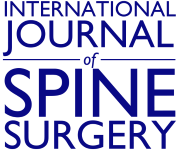Article Figures & Data
Tables
- Table 1
Inclusion and Exclusion Criteria for ProDisc-L (from the FDA SS&E labelling document).
Inclusion Exclusion Degenerative Disc Disease (DDD) in one vertebral level between L3 and S1. Diagnosis of DDD requires back and/or leg (radicular pain); and radiographic confirmation of any 1 of the following by CT, MRI, discography, plain film, myelography and/or flexion/extension films:
Instability (≥3mm translation or ≥5° angulation;
Decreased disc height >2mm;
Scarring/thickening of annulus fibrosis;
Herniated nucleus pulposus; or
Vacuum phenomenon
Age between 18 and 60 years
Failed at least 6 months of conservative treatment
Oswestry Low Back Pain Disability Questionnaire score of at least 20/50 (40%) (Interpreted as moderate/severe disability)
Psychosocially, mentally and physically able to fully comply with this protocol including adhering to follow-up schedule and
Signed inform consent
No more than 1 vertebral level may have DDD, and all diseased levels must be treated
Patients with involved vertebral endplates dimensionally smaller than 34.5 mm in the medial-lateral and/or 27 mm in the anterior-posterior directions
Known allergy to titanium, polyethylene, cobalt, chromium or molybdenum
Prior fusion surgery at any vertebral level
Clinically compromised vertebral bodies at the affected level due to current or past trauma
Radiographic confirmation of facet joint disease or degeneration
Lytic spondylolisthesis or spinal stenosis
Degenerative spondylolisthesis of grade > 1
Back or leg pain of unknown etiology
Osteopenia or osteoporosis: A screening questionnaire for osteoporosis, SCORE (Simple Calculated Osteoporosis Risk Estimation), will be used to screen patients to determine if a DEXA scan is required. If DEXA is required, exclusion will be defined as a DEXA bone density measured T score < -2.5.
Paget's disease, osteomalacia or anything other metabolic bone disease (excluding osteoporosis which is addressed above)
Morbid obesity defined as a body mass index > 40 or a weight more than 100 lbs. over ideal body weight
Pregnant or interested in becoming pregnant in the next 3 years
Active infection – systemic or local
Taking medication or any drug known to potentially interfere with bone/soft tissue healing (e.g., steroids)
Rheumatoid arthritis or other autoimmune disease
Systemic disease including AIDS, HIV, Hepatitis
Active malignancy: A patient with a history of any invasive malignancy (except non-melanoma skin cancer) unless he/she has been treated with curative intent and there has been no clinical signs or symptoms of the malignancy for at least 5 years
Indications for Use Contraindications The ProDisc-L Total Disc Replacement is indicated for spinal arthroplasty in skeletally mature patients with degenerative disc disease (DDD) at one level from L3-S1. DDD is defined as discogenic back pain with degeneration of the disc confirmed by patient history and radiographic studies. These DDD patients should have no more than Grade 1 spondylolisthesis at the involved level. Patients receiving the ProDisc-L Total Disc Replacement should have failed at least six months of conservative treatment prior to implantation of the ProDisc-L Total Disc Replacement. The ProDisc-L Total Disc Replacement should not be implanted in patients with the following conditions: Active systemic infection or infection localized to the site of implantation
Osteopenia or osteoporosis defined as DEXA bone density measured T-score < -1.0
Bony lumbar spinal stenosis
Allergy or sensitivity to implant materials (cobalt, chromium, molybdenum, polyethylene, titanium)
Isolated radicular compression syndromes, especially due to disc herniation
Pars defect
Involved vertebral endplate that is dimensionally smaller than 34.5 mm in the medial-lateral and/or 27mm in the anterior-posterior directions
Clinically compromised vertebral bodies at the affected level due to current or past trauma
Lytic spondylolisthesis or degenerative spondylolisthesis of grade > 1






